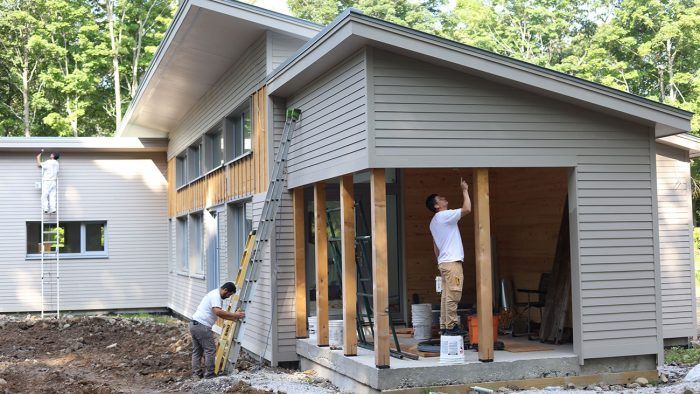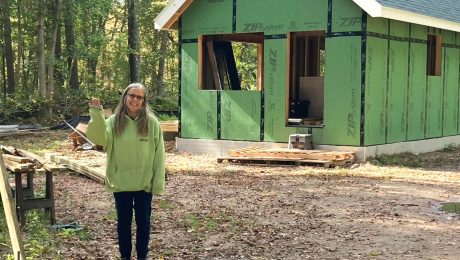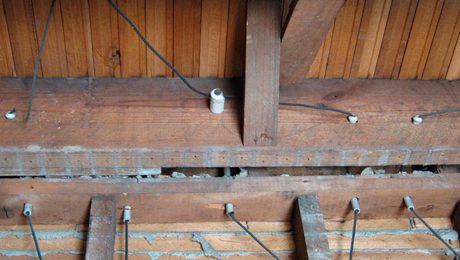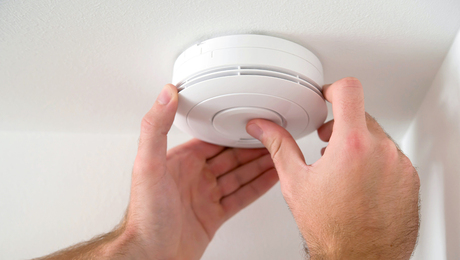6 Rules for Quality, Safe, and Efficient Labor
In a society in which building mentors may be hard to find, Kevin Ireton offers advice for how to go about doing the hard part of building.

When I take my wife’s van into the Honda dealer for service, I drive through overhead doors that open automatically and pull into a big cavernous space, with clean floors and service desks manned by attendants dressed for business. There are no mechanics wiping their hands on rags or leaning into the maw of a wounded CR-V. You don’t hear the clanging of a box wrench dropped on a concrete floor or the burp of an impact gun loosening lug nuts.
Maybe the car-repair experience has been sanitized for safety reasons and to avoid lawsuits, but I think there’s more to it. I think a lot of customers don’t want to see people with grease on their hands or hear the sound of cars actually being repaired. We live in a society that doesn’t much value hard, physical work anymore. We tend to look down on people who use their hands to build or fix things. And when we need those people to unclog a drain or to get a car running again, we resent the prices they charge.
Instead, most folks want their kids to go to college and to work in an office. It’s an integral part of the American Dream for parents to want a better life for their children, and to most people, “better” means mean easier.
I disagree.
We’ve chased comfort and convenience for so long that we’ve forgotten the pleasures that can only come from being uncomfortable and inconvenienced. As someone who has had one foot in the white-collar world and one in the blue-collar world for much of his life, I can honestly say that my best moments have either been the act of hard, physical work—usually with others, fighting the weather or the fading daylight to pour a slab or frame a roof—or the enjoyment of its results—dinner with friends on a porch that we built together.
Thanks to the eroding tradition of physical work, the knowledge of how to do it is disappearing. There are fewer and fewer skilled workers to teach those just getting started. People have to figure things out for themselves, and the results are uneven at best. Without a teacher to guide them, they often get frustrated and quit.
Maybe because I never had a real mentor (except for the authors of this magazine), I developed my own set of working rules to keep me on track. If you work by the hour, you’re obligated to work efficiently and to produce consistent results. Having a few rules can help when you’re frustrated or tired and not thinking as clearly as you otherwise might. Most of these rules are designed to help me overcome the negative aspects of basic human nature, so you might find them useful whatever kind of work you do.
1. Just begin
Most jobs, especially those you dread, get easier once you begin. Digging is a good example. I hate digging. Digging by hand. Digging with a shovel. Or more accurately, I think I hate digging. So I dread it with considerable vigor and put it off as long as I can, which of course allows the dread to reach epic proportions.
But once I begin, two things inevitably happen. First, I’m amazed at how much dirt I can move in a half hour. Even the biggest jobs begin to seem doable. And second, when I stop dreading and start digging, I begin to enjoy the work. It becomes a physical meditation, like yoga or tai chi.
2. Be methodical
Even with the most mundane tasks, I try to be logical and to have a plan. If I’m moving heavy things, I start with the heaviest. I’ve got all of my strength at that point and things will get easier as I proceed. The same goes for distance. If I’m moving items—rocks, lumber, etc.—I start with those that are the farthest away. The point here is that you don’t just do things randomly, especially repetitive tasks. You think about it and look for the best way to do a thing. The fastest way. The safest way. The most efficient way. The way that yields the best result.
If you’re painting a door, you work from the inside out, panels first, then stiles and rails. If your installing crown molding, you work counterclockwise around the room (assuming you’re right handed), butt joints on the left end, coped joints on the right. These are the insights a wizened veteran would pass along to you. But in the absence of such guidance, you have to find your own wisdom by looking for the logical approach to the task at hand.
3. Don’t base decisions on laziness
This rule is critical to working safely and well, but it is very hard to follow. The little devil sitting on your shoulder is constantly telling you not to bother drilling a pilot hole for that screw or that you can stand on an upturned drywall bucket rather than taking the time to get the ladder. One day, many years ago, while resawing a piece of hardwood on the table saw, I listened to that little voice and lost a fingertip.
Doing the right thing when you’re building a house, whether it’s sloping the footing drains properly, installing fiberglass batts correctly, or flashing a chimney, is often hard and time consuming and sometimes expensive. The work is challenging, and you’re probably tired, which is a bad combination. It makes you vulnerable to laziness and bad decisions. So as often as I can when pondering a decision, I ask myself if I’m choosing a certain path because it’s the right thing or if I’m just being lazy. Calling myself names doesn’t always goad me into doing the right thing, but it helps.
4. Work from the correct position
This rule is a corollary of the laziness rule (and there are many), but I give it its own place because of how often I’m tempted to violate it. For example, the reason I’m inclined to reach way over and drive one more nail is because I’m too lazy to get down and move the ladder. But when I do reach and swing the hammer from some awkward position, I inevitably miss and leave an impressive hammer mark that commemorates my laziness.
Some years ago while working on his new garage, a friend of mine reached too far at the top of the ladder. He’s a big guy and his shifting weight made the ladder slide sideways. He woke up with broken ribs and a punctured lung.
Sometimes you have to work from an awkward position. But if you have a choice, get in the right position. It’s safer. It’s easier on your wrists, elbows and shoulders. And it’s likely to result in better work.
5. Don’t leave things to do later
I’m loading tools and materials onto my pickup truck. I put a couple of 2x4s up on the lumber rack and think to myself, “I’ll tie them down later.” Bad idea. I’ll forget, and in ten minutes, when I slam on the brakes at a stoplight, the 2x4s will go flying into the S-Class Mercedes in front of me (it’s never a 20-year-old Corolla).
At this point, I can usually recognize those tasks that are likely to get forgotten, like grabbing my coffee mug off the bumper of my pickup or putting in the rest of the screws when installing drawer slides. I do them when I think of them, and if I can’t, I write them down on a list. (Of course, remembering to look at the list is a whole other problem.)
6. Don’t try to solve problems at the end of the day
I can’t tell you the number of times when I made a mistake or encountered a problem toward the end of the day, and it seemed insurmountable. But when I arrived at work the next morning I had a solution.
I recently built a dedicated coffee station into a small niche in my kitchen—12-in.-deep cabinets below, a counter where the coffee maker and grinder would sit, and 12-in. cabinets above. I was very careful to leave enough space between the upper and lower cabinets for the coffee maker. I even went online and looked at other coffee makers to make sure than any future appliances would fit. But after building and installing the plywood boxes, I suddenly got that sinking feeling in my gut. Yes, there was room for the coffee maker, but there wasn’t room to flip open it’s lid, much less pour water into it. Typically, a coffee maker sits on a 25-in. deep counter, and you can slide the coffee maker forward to fill it. My counter was only going to be 12 in. deep. Uh oh.
It was the end of the day. I was tired. I was angry. And I was pretty sure I would to have to scrap the idea of a coffee station. But I walked away, knowing that if there was a solution, it would come later, not at that moment. The next day I had the answer. I could install the counter on full-extension drawer slides. Pull it out to fill the coffee maker, then push it back in place for brewing. And in the interest of full disclosure, yes, my wife might have suggested this particular solution—but that doesn’t negate the rule.
I have lots of other rules—question your assumptions, never leave tools on top of the step ladder, don’t put tools away before the end of the day—but those listed above are the ones I find most useful. They may not be right for you. You may have to come up with your own. If so, the goal is to create rules that help you work efficiently, achieve good results, and most important, counteract your own worst impulses. And if at all possible, pass along your rules to someone else with less experience.
Kevin Ireton, editor-at-large, is a writer and remodeling contactor who divides his time between Connecticut and Arizona.
Photo by Rodney Diaz
RELATED STORIES






























View Comments
Check out Shop Class as Soulcraft: An Inquiry into the Value of Work for an interesting dissertation on this subject.
https://www.penguinrandomhouse.com/books/301618/shop-class-as-soulcraft-by-matthew-b-crawford/?campaign_id=58&emc=edit_ck_20211219&instance_id=48172&nl=cooking®i_id=42976029&segment_id=77440&te=1&user_id=3051122b79e726ec56fd122406c597aa
Great point of view and insights, Kevin. Enjoyed the article.